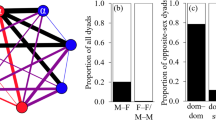Summary
The benefits to partners of monogamous pairs of maintaining continual spatial proximity in the non-breeding season were studied in Bewick's swans wintering in Norfolk, UK.
When separated from their mates, females were less successful in aggressive encounters, were threatened more frequently and spent less time feeding than when close to them. Males also suffered reduced success in encounters and a higher frequency of threats by other flock members, though the effect was less pronounced than for females. This sex difference in effect of separation may be associated with the greater weight of males and the fact that success in encounters is related to weight.
Partners appeared to assist each other by joining in aggressive encounters, as well as by ‘inhibiting’ other birds from threatening their mates. However, the precise manner in which the female assisted the male is still obscure, since the highest intensity aggressive encounters — physical fights — involved only male partners. It is suggested that the male may fight harder in his mate's presence.
Proximity of partners varied with situation and between different pairs. Partners maintained greater proximity in dense flocks than in dispersed flocks and showed a tendency to stay closer when feeding on winter wheat than on waste potatoes. Partners where the male was high-ranking spent more time together than those where the male was low-ranking.
Similar content being viewed by others
References
Ashcroft RE (1976) A function of the pairbond in the Common Eider. Wildfowl 27:101–106
Bateson PPG (1977) Testing an observer's ability to identify individual animals. Anim Behav 25:247–248
Coulson JC (1966) The influence of the pair-bond and age on the breeding biology of the Kittiwake Gull Rissa tridactyla. J Anim Ecol 35:269–279
Evans ME (1977) Recognizing individual Bewick's swans by bill pattern. Wildfowl 28:153–158
Evans ME (1978) Some factors infuencing the use of a wintering site by Bewick's swans, studied through individual identification. MSci thesis, University of Wales
Evans ME, Kear J (1978) Weights and measurements of Bewick's swans during winter. Wildfowl 29:118–122
Kear J (1970) The adaptive radiation of parental care in waterfowl. In: Crook JH (ed) Social behaviour in birds and mammals. Academic Press, London, pp 357–392
Kendeigh SC (1952) Parental care and its evolution in birds. Ill Biol Monogr 22 (1–3)
Kunkel P (1974) Mating systems of tropical birds: the effects of weakness or absence of external reproductive timing factors with special reference to prolonged pair bonds. Z Tierpsychol 34:264–307
Lack D (1968) Ecological adaptations for breeding in birds. Methuen, London
Lockie J (1956) Winter fighting in feeding flocks of rooks, jackdaws and carrion crows. Bird Study 3:180–190
Owen M, Gullestad N, St-Joseph AKM (1977) Barnacle Goose Project 1976–77. Wildfowl Trust (unpublished report)
Prevett JP (1972) Family behavior and age-dependent breeding biology of the blue goose, Anser caerulescens. PhD thesis, University of Western Ontario
Röell A (1978) Social behaviour of the Jackdaw (Corvus monedula) in relation to its niche. Behaviour 64:1–124
Scott DK (1967) The Bewick's swans at Slimbridge 1966 and 1967. Wildfowl Trust Annu Rep 18:24–27
Scott DK (1978a) Social behaviour of wintering Bewick's swans. PhD thesis, University of Cambridge
Scott DK (1978b) Identification of individual Bewick's swans by bill pattern. In: Stonehouse B (ed) Animal marking. Macmillan, London, pp 160–168
Scott DK (1980) Functional aspects of prolonged parental care in Bewick's swans. Anim Behav 28:938–952
Scott DK (to be published) The behaviour of Bewick's swans on the Welney Wildfowl Refuge, U.K., and on surrounding fenland: a comparison. Wildfowl 31:000-000
Scott P (1966) The Bewick's swans at Slimbridge. Wilfowl Trust Annu Rep 17:20–26
Zann R (1977) Pair-bond and bonding behaviour in three species of grassfinches of the genus Poephilá (Gould). Emu 77:97–106
Author information
Authors and Affiliations
Rights and permissions
About this article
Cite this article
Scott, D.K. Functional aspects of the pair bond in winter in Bewick's swans (Cygnus columbianus bewickii). Behav Ecol Sociobiol 7, 323–327 (1980). https://doi.org/10.1007/BF00300673
Received:
Accepted:
Issue Date:
DOI: https://doi.org/10.1007/BF00300673




